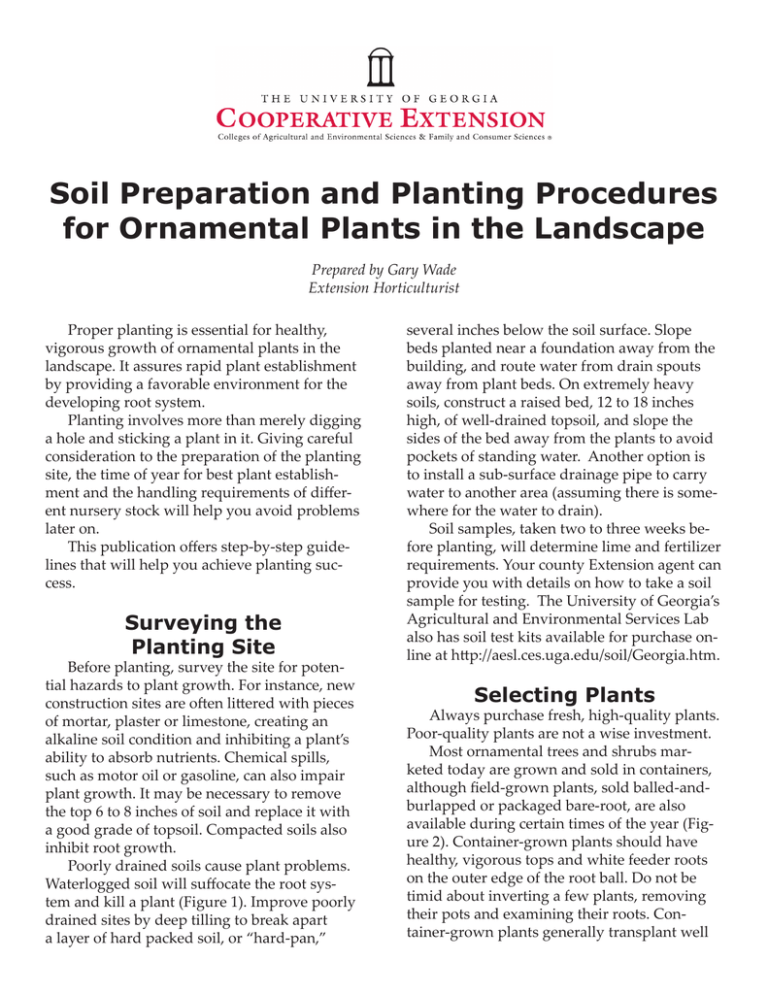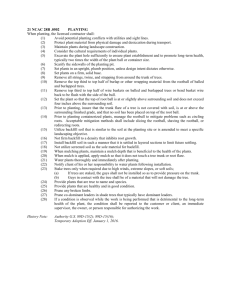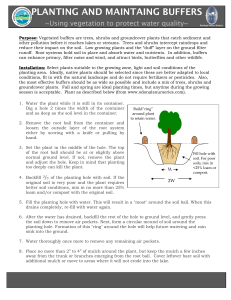Soil Preparation and Planting Procedures for Ornamental Plants in the Landscape
advertisement

Soil Preparation and Planting Procedures for Ornamental Plants in the Landscape Prepared by Gary Wade Extension Horticulturist Proper planting is essential for healthy, vigorous growth of ornamental plants in the landscape. It assures rapid plant establishment by providing a favorable environment for the developing root system. Planting involves more than merely digging a hole and sticking a plant in it. Giving careful consideration to the preparation of the planting site, the time of year for best plant establishment and the handling requirements of different nursery stock will help you avoid problems later on. This publication offers step-by-step guidelines that will help you achieve planting success. several inches below the soil surface. Slope beds planted near a foundation away from the building, and route water from drain spouts away from plant beds. On extremely heavy soils, construct a raised bed, 12 to 18 inches high, of well-drained topsoil, and slope the sides of the bed away from the plants to avoid pockets of standing water. Another option is to install a sub-surface drainage pipe to carry water to another area (assuming there is somewhere for the water to drain). Soil samples, taken two to three weeks before planting, will determine lime and fertilizer requirements. Your county Extension agent can provide you with details on how to take a soil sample for testing. The University of Georgia’s Agricultural and Environmental Services Lab also has soil test kits available for purchase online at http://aesl.ces.uga.edu/soil/Georgia.htm. Surveying the Planting Site Before planting, survey the site for potential hazards to plant growth. For instance, new construction sites are often littered with pieces of mortar, plaster or limestone, creating an alkaline soil condition and inhibiting a plant’s ability to absorb nutrients. Chemical spills, such as motor oil or gasoline, can also impair plant growth. It may be necessary to remove the top 6 to 8 inches of soil and replace it with a good grade of topsoil. Compacted soils also inhibit root growth. Poorly drained soils cause plant problems. Waterlogged soil will suffocate the root system and kill a plant (Figure 1). Improve poorly drained sites by deep tilling to break apart a layer of hard packed soil, or “hard-pan,” Selecting Plants Always purchase fresh, high-quality plants. Poor-quality plants are not a wise investment. Most ornamental trees and shrubs marketed today are grown and sold in containers, although field-grown plants, sold balled-andburlapped or packaged bare-root, are also available during certain times of the year (Figure 2). Container-grown plants should have healthy, vigorous tops and white feeder roots on the outer edge of the root ball. Do not be timid about inverting a few plants, removing their pots and examining their roots. Container-grown plants generally transplant well 1 throughout most of the year with minimum shock, although fall and winter months are the best time to transplant. Large trees and shrubs grown in the field are often sold balled-and-burlapped. Because a large portion of the root system is destroyed during digging, they transplant best during the cooler months (October through April). Some trees are grown and marketed in fabric bags, and can be transplanted throughout the year, although the fall and winter months are best. Packaged bare-root plants, such as roses, should have plump, healthy stems and good root systems that are kept moist in a packing substance like sphagnum moss or wood shavings. The best planting time for these plants is from December to mid-March. face. Some landscape professionals plant the top of the root ball 1 to 2 inches above grade if they know the soil is likely to settle slightly. Research has also shown that it is not necessary to add organic amendments, such as peat moss, compost or leaf mold, to the planting hole. Organic matter can act like a sponge in the planting hole, absorbing and holding too much moisture and causing the roots to stay too wet. When planting just one plant, it is best to backfill with the same soil removed from the hole. Be sure to break apart any clods and remove stones or other debris before refilling the hole. Before planting balled-and-burlapped plants, cut any wire or cord from around the trunk and pull back the burlap from the top one-third of the root ball. This will allow newly formed feeder roots to grow into the new environment. When planting on poorly drained soils, remove the burlap completely. When planting trees or shrubs grown in fabric bags, remove the entire bag before planting (Figure 4). To eliminate air pockets, water the planting site as the backfill soil is placed in the hole. Use your hand, not your foot, to gently firm the soil around the roots. Water thoroughly when finished and water again several hours later. Slow-release or liquid fertilizers can be added to the planting hole, but granular generalpurpose fertilizers, such as 8-8-8 or 10-10-10, can damage tender roots. Wait until the plants are established before applying a granular general-purpose fertilizer. (See section on caring for newly planted trees and shrubs.) Finally, shape a small ring of soil, 2 to 3 inches high, along the perimeter of the planting hole. This forms a saucer on top of the soil, which directs water to the roots and prevents runoff. Finally, uniformly apply a 3-inch layer of mulch over the soil surface. Mulches promote rapid rooting by maintaining uniform moisture levels and temperatures in the soil and by preventing weed competition. Landscape fabrics can be placed under the mulch to help prevent weeds and to conserve moisture. Holding Plants Until They are Planted If plants cannot be planted right away, place them in a shaded area and keep the roots moist. If balled-and-burlapped or bare-root plants must be held several days before planting, cover their roots with sawdust, pine straw or soil to conserve moisture. Avoid placing the roots in water or buckets for long periods of time because they will suffocate. Container plants may need daily watering. Make sure plants are well watered before planting and ensure the root ball is thoroughly wet. A dry root ball is difficult to rewet after transplanting. Planting in Individual Holes The old adage “never put a ten-dollar tree in a two-dollar hole” applies when planting individual trees and shrubs. Research at the University of Georgia has shown that a large planting hole – at least twice as wide as the root ball -- encourages rapid root growth and plant establishment. Dig the planting hole only as deep as the root ball (Figure 3). If the hole is dug deeper, backfill it with soil as necessary and tamp it firmly to prevent settling. Make certain the top of the root ball is level with the soil sur2 and prevent weeds. Fine-textured mulches, such as pine straw or pine bark mini-nuggets, stay seated better on the bed than coarse-textured mulches. Finally, water thoroughly. A liquid fertilizer can be applied with the water at planting to provide some immediate nutrients. Planting in Beds A group of ornamental plants in one area of the landscape will grow more uniformly when planted in a well-prepared bed rather than in individual holes. Begin by deep tilling to a depth of 12 to 15 inches (Figure 5). Then incorporate about 1 pound (2 cups) of an eight to 10 percent nitrogen fertilizer, such as 8-8-8 or 1010-10, over every 100 square feet of bed area. Only incorporate lime into the bed if the soil test recommends it. After preparing the soil, follow the planting procedure recommended for planting in individual holes. Staking and Guying Trees Protective staking may be necessary for young trees, trees less than 4 feet tall, or trees planted in high foot-traffic areas, such as school grounds or shopping centers. Stakes also protect young tree trunks from lawn mowers and weed eaters, which can severely damage the bark. An area of mulch around the tree is an alternative to protective staking. Trees with a trunk diameter greater than 1 inch and a height exceeding 4 feet need staking or guy wires to hold them in place until they are established (Figure 8). Staking or guying a tree keeps it from blowing over and uprooting during establishment. Trees with a trunk diameter up to 3 inches can be supported by two to four stakes, depending on the size of the canopy. After they are placed in the ground, the height of the stakes should equal the height of the lowest scaffold branches. Place the stakes along the perimeter of the planting hole, and pound them several inches into the ground to hold them firmly in place. Secure the tree to the stakes with strong, 12-gauge wire. Attach the wire just above the lowest scaffold branches. Place the wire encircling the tree in a piece of old garden hose to prevent bark injury. Use three guy wires for trees larger than 4 inches in trunk diameter. Give the tree some slack so it can move slightly with the breeze. Research indicates that a tree allowed some movement during establishment develops a larger root system and stronger trunk than one that is kept stationary. Remove stakes and guy wires four to six months after planting to prevent girdling and trunk injury. Remove stakes from fall-planted trees at the start of the spring growing season and from spring-planted trees at the end of the summer growing season. Continued on Page 6 Planting Annuals and Herbaceous Perennials To achieve the best color displays, annuals and herbaceous perennials must have good drainage, adequate nutrients and available water at all times. Begin by deep tilling the native soil to improve its structure and to ensure good drainage. Then, elevate the bed 6 to 12 inches by adding soil amendments. A raised bed not only ensures good drainage, but also improves the visibility of the color display (Figures 6 and 7). The type and quantity of soil amendments used depends on the structure and texture of the existing soil, and whether amendments have been previously added to the site. A combination of composted organic matter, composted animal manure and large-particle sand, such as Lithonia granite, are frequently used to amend beds. If bagged organic amendments are used, apply one 40-pound bag per 100 square feet of bed area and incorporate it to a 6- to 8-inch depth. An ideal soil is moist, yet well drained. Slow-release fertilizers, such as Osmocote, are excellent for flowerbeds because they give the plants an even supply of nutrients throughout the growing season. Several formulas are available, although one with at least an eightto nine-month release duration is recommended. Follow manufacturer recommendations for application rate. After planting, apply about 3 inches of mulch on the soil surface to conserve moisture 3 Figure 1. Ornamentals can be grown on poorly-drained soils if they are planted on raised beds. Figure 2. Woody ornamentals for the landscape are commonly sold three ways: container-grown (left), balled-and-burlapped (center) and bare-rooted (right). Figure 3. Dig the planting hole two times wider than the root ball. Make certain the top of the root ball is level with the soil surface. Figure 4. This balled-and-burlapped plant, with the cord cut from around the trunk and the burlap pulled back, is ready for planting. Figure 5. When planting a group of ornamental plants in the landscape, prepare a good bed by deep tilling to a depth of 12 to 15 inches. Figure 6. Plant annuals and perennials on raised beds to ensure good drainage and improved visibility. 4 Figure 7. Containers let you put splashes of color where you want it, regardless of soil type, and offer an alternative to flowerbeds. For best results, use quality potting soil and a well-drained container. Figure 8. Trees with a trunk diameter greater than 1 inch and a height exceeding 4 feet usually require staking or guying. Figure 9. A root ball staking system is an alternative to guy wires. 5 Continued on from Page 3 of a 12 to 16 percent nitrogen source (12-4-8 or 16-4-8) or 1 level tablespoon of an eight to 10 percent nitrogen source (8-8-8 or 10-10-10) three times during the growing season (March through September). Broadcast the fertilizer along the perimeter of the planting hole. Give trees 2 tablespoons of a 12 to 16 percent nitrogen source for each inch of trunk diameter three times during their first growing season. Broadcast fertilizers evenly over an area extending 6 inches from the trunk to 1 foot beyond the branch spread or canopy. Newly planted ground covers benefit from a complete, balanced fertilizer, like 8-8-8 or 1010-10. An application rate of 1 pound per 100 square feet is sufficient. When broadcasting fertilizers over the top of the foliage, be sure the foliage is dry, and water soon after application. For information on the care of established ornamental plants, see Georgia Cooperative Extension Bulletin 1065, Care of Ornamental Plants in the Landscape. An alternative staking method that is becoming more popular with arborists and landscape professionals involves placing four wooden stakes (2 x 2 inches wide and 4 feet long) opposite one another just outside the root ball, leaving 4 inches of each stake protruding from the soil. Screws are used to secure two additional 2 x 2-inch stakes to the vertical stakes (Figure 9). This technique prevents the root ball from rocking during establishment, and does not harm the bark of the tree like guy wires sometimes do. Trunk Wrapping Trees often have their trunks wrapped to prevent injury during transport from the nursery to the garden center. When purchasing a tree with its trunk wrapped, remove the wrapping at planting time or shortly thereafter. It is not necessary to wrap the trunk of newlyplanted trees. Steps for Planting Success Care of Newly Planted Ornamental Plants Watering: Regular watering is critical during establishment of newly planted trees and shrubs. Keep the root system moist, but not too wet, for the first six to eight weeks after planting. The amount of water and frequency of application depend on the soil type and the type of plant. Trees and shrubs may require watering twice a week when there is no rain. Annuals and ground covers may need daily watering during establishment. Let soil moisture be your guide for watering frequency. Fertilization: There are many slow-release fertilizers on the market that feed plants from six to 12 months with one application. Slow-release fertilizers generally cost more than general-purpose fertilizers, but they require fewer applications. Follow application guidelines on the bag or container. If you use general-purpose fertilizers, use light applications for newly-planted ornamentals during the first growing season. For shrubs less than 12 inches tall, apply 1 level teaspoon 6 1. Survey the planting site. Modify the site, if necessary, to ensure a good growing environment. Select plants adapted to the site conditions. 2. Purchase healthy, pest-free plants. 3. When holding plants for later planting, keep them in the shade and water them regularly. 4. Water plants thoroughly before planting to saturate the root ball with water. 5. Thorough soil preparation is essential for healthy plant growth. When planting a group of plants, rototill the soil to a depth of 12 to 15 inches. When planting a single tree or shrub, dig the planting hole two to three times wider than the root ball. 6. Place the plant in the hole so the top of the root ball is level with the soil surface. 7. Remove any wire or cord from around the stem of balled-and-burlapped plants. Pull back or remove the burlap from the root ball if possible. 8. Water thoroughly immediately after planting to settle the soil and to eliminate air pockets, which can dry out roots. 9. Use stakes or guy wires to support trees or large shrubs on exposed, windy sites. Supporting devices are only temporary and should be removed a few weeks after transplanting. 10.Apply 3 to 5 inches of mulch to the soil surface to conserve moisture and to prevent weeds. 11.Water as necessary during the establishment period. Keep the soil uniformly moist — not too wet or too dry. 12.Allow trees and shrubs time to become established before applying fertilizer. Number of Plants Required per 100 Square Feet at Various Spacings Spacing (inches between plants) Number of Plants Needed 4 900 6 400 8 225 9 178 10 144 12 100 16 56 18 45 24 25 30 16 36 11 Approximate Number of Cubic Yards of Compost or Topsoil Required per 1,000 Square Feet when Applied at Various Depths Application Depth (inches)* Approximate Number of Cubic Yards ¼ ½ 1 1½ 2 1 2 3 5 6 * 1 inch of amendment applied to the soil surface and incorporated to a depth of 10 inches will provide an approximately 10 percent increase in organic matter content. A 10 percent to 30 percent increase in organic matter is ideal for annuals and perennials. There are 27 cubic feet in a cubic yard; therefore, nine bags (3 cubic feet in size) are equivalent to 1 cubic yard. 7 Bulletin 932 / Revised February 2010 The University of Georgia and Ft. Valley State University, the U.S. Department of Agriculture and counties of the state cooperating. The Cooperative Extension Service, the University of Georgia College of Agricultural and Environmental Sciences offers educational programs, assistance and materials to all people without regard to race, color, national origin, age, sex or disability. An Equal Opportunity Employer/Affirmative Action Organization Committed to a Diverse Work Force 8



